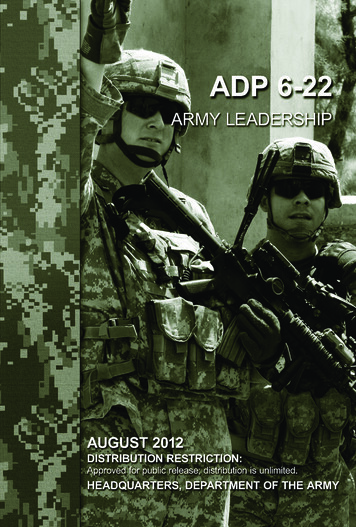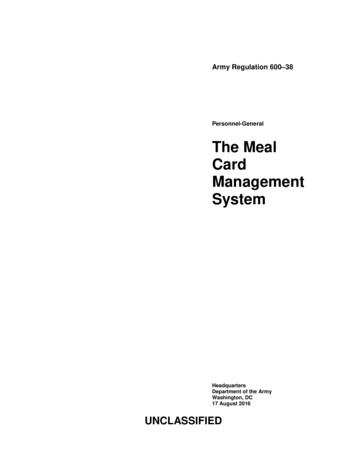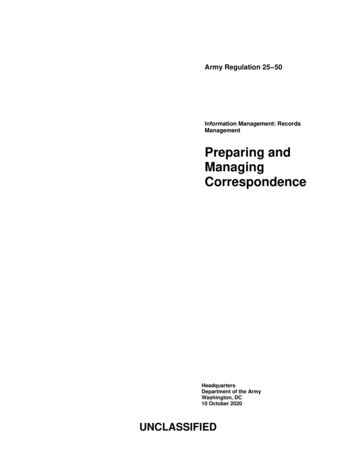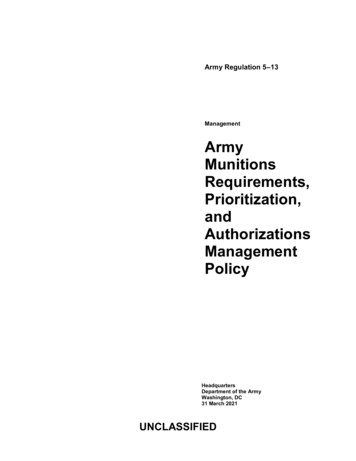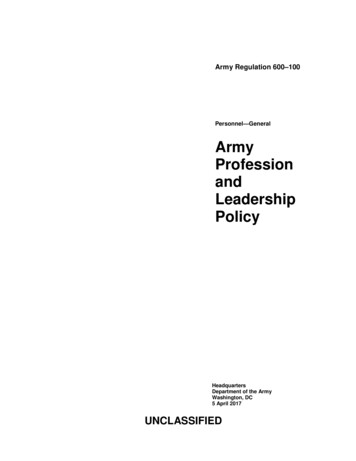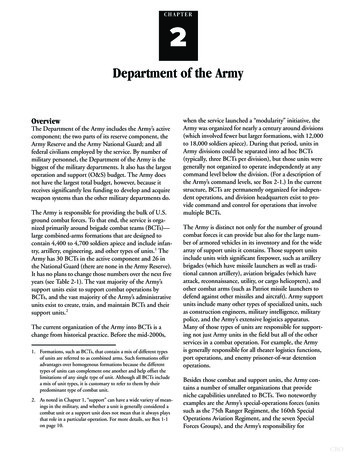
Transcription
CHAPTER2Department of the ArmyOverviewThe Department of the Army includes the Army’s activecomponent; the two parts of its reserve component, theArmy Reserve and the Army National Guard; and allfederal civilians employed by the service. By number ofmilitary personnel, the Department of the Army is thebiggest of the military departments. It also has the largestoperation and support (O&S) budget. The Army doesnot have the largest total budget, however, because itreceives significantly less funding to develop and acquireweapon systems than the other military departments do.The Army is responsible for providing the bulk of U.S.ground combat forces. To that end, the service is organized primarily around brigade combat teams (BCTs)—large combined-arms formations that are designed tocontain 4,400 to 4,700 soldiers apiece and include infantry, artillery, engineering, and other types of units.1 TheArmy has 30 BCTs in the active component and 26 inthe National Guard (there are none in the Army Reserve).It has no plans to change those numbers over the next fiveyears (see Table 2-1). The vast majority of the Army’ssupport units exist to support combat operations byBCTs, and the vast majority of the Army’s administrativeunits exist to create, train, and maintain BCTs and theirsupport units.2The current organization of the Army into BCTs is achange from historical practice. Before the mid-2000s,1. Formations, such as BCTs, that contain a mix of different typesof units are referred to as combined arms. Such formations offeradvantages over homogenous formations because the differenttypes of units can complement one another and help offset thelimitations of any single type of unit. Although all BCTs includea mix of unit types, it is customary to refer to them by theirpredominant type of combat unit.2. As noted in Chapter 1, “support” can have a wide variety of meanings in the military, and whether a unit is generally considered acombat unit or a support unit does not mean that it always playsthat role in a particular operation. For more details, see Box 1-1on page 10.when the service launched a “modularity” initiative, theArmy was organized for nearly a century around divisions(which involved fewer but larger formations, with 12,000to 18,000 soldiers apiece). During that period, units inArmy divisions could be separated into ad hoc BCTs(typically, three BCTs per division), but those units weregenerally not organized to operate independently at anycommand level below the division. (For a description ofthe Army’s command levels, see Box 2-1.) In the currentstructure, BCTs are permanently organized for independent operations, and division headquarters exist to provide command and control for operations that involvemultiple BCTs.The Army is distinct not only for the number of groundcombat forces it can provide but also for the large number of armored vehicles in its inventory and for the widearray of support units it contains. Those support unitsinclude units with significant firepower, such as artillerybrigades (which have missile launchers as well as traditional cannon artillery), aviation brigades (which haveattack, reconnaissance, utility, or cargo helicopters), andother combat arms (such as Patriot missile launchers todefend against other missiles and aircraft). Army supportunits include many other types of specialized units, suchas construction engineers, military intelligence, militarypolice, and the Army’s extensive logistics apparatus.Many of those types of units are responsible for supporting not just Army units in the field but all of the otherservices in a combat operation. For example, the Armyis generally responsible for all theater logistics functions,port operations, and enemy prisoner-of-war detentionoperations.Besides those combat and support units, the Army contains a number of smaller organizations that provideniche capabilities unrelated to BCTs. Two noteworthyexamples are the Army’s special-operations forces (unitssuch as the 75th Ranger Regiment, the 160th SpecialOperations Aviation Regiment, and the seven SpecialForces Groups), and the Army’s responsibility forCBO
18THE U.S. MILITARY’S FORCE STRUCTURE: A PRIMERJULY 2016occurred during the occupation of Iraq. (For more discussion of the implications of that structure, see the specialtopic entry about integration of the Army’s active andreserve components on page 38.)Table 2-1.Number of Major Combat Units in the Army,2017 and 202120172021Armored Brigade Combat TeamsActive componentNational Guard9595Stryker Brigade Combat TeamsActive componentNational Guard7272Infantry Brigade Combat TeamsActive componentNational Guard1419141930263026Total Brigade Combat TeamsActive componentNational GuardCommand Levels and UnitsSource: Congressional Budget Office, using data from the Department ofDefense’s 2017 budget request.operating the Ground-Based Midcourse Defense portionof the national missile defense system (both of which arediscussed in Chapter 5).Distribution of Army PersonnelOf the nearly 1 million military personnel serving in theArmy as a whole, roughly half are in support units and athird are in combat units (see Table 2-2). The rest belongto units that perform various overhead functions, such asrecruiting, training, and equipping combat units. TheArmy’s reserve component is slightly larger than itsactive component, with 54 percent of the service’s totalpersonnel.Since the 1970s, the Army has interpreted the Department of Defense’s Total Force Policy—which involvestreating a service’s various components as a single force—by concentrating combat units in the active componentand support units in the reserve component. Over the2017–2021 period, the Army plans to have an average of59 percent of its combat personnel in the active component and 75 percent of its support personnel in thereserve component. The practical effect of that distribution is that the Army has enough support units in itsactive component to conduct relatively small operationson its own, but larger combat operations usually requireit to mobilize a significant number of reservists to providesupport for the active-component combat units—asCBOThe Army’s combat units are organized in a recursivepattern: A unit at any command level contains two to fivesubordinate units of a similar type, plus additional supporting units. For example, an infantry brigade has two orthree infantry battalions, a cavalry squadron, and a singlebattalion each of special troops, artillery, engineers, andlogistics.3 Similarly, an infantry battalion has three infantry companies, a heavy weapons company, and a headquarters company. That pattern is repeated at lower levels(a company consists of platoons, and platoons consist ofsquads) and at higher levels (a division consists of brigadecombat teams, and a corps consists of divisions), asdetailed in Box 2-1. However, some command levels havedifferent names depending on the type of unit; forinstance, cavalry squadrons are at the same commandlevel as infantry battalions.This analysis treats supporting units as directly connectedto combat units in a fixed relationship, but that treatmentis an approximation that is valid only when discussingforce planning. In actual operations, most support unitsare assigned to higher command levels, which give themspecific missions. A BCT does not include the supportunits that the Congressional Budget Office attributes toit in this analysis—those units are division-, corps-, ortheater-level assets that would be deployed to support theBCT and without which the BCT could not function.Furthermore, although the Army’s plans involve maintaining a given set of units in the force structure, thecommander of a specific operation can, and often does,tailor the mix of support units that are deployed to suitthe circumstances of a particular theater of operations.For example, during the occupation of Iraq, the Armygenerally did not deploy artillery or air-defense units,although it had them in its force structure. Such unitswere considered unnecessary in that operation, and somewere converted to perform roles deemed more useful during the occupation, such as protecting supply convoys.3. Cavalry units are units that perform the same armed reconnaissance role once carried out by troops on horseback. Today,cavalry units are equipped with helicopters, tanks, armoredfighting vehicles, or wheeled vehicles.
CHAPTER 2: DEPARTMENT OF THE ARMYTHE U.S. MILITARY’S FORCE STRUCTURE: A PRIMER19Box 2-1.Command Levels of U.S. Ground ForcesThe Army and Marine Corps are generally organizedas hierarchies of units, with each type of unit commanded by a noncommissioned or commissionedofficer of a specific rank. (Officers of other ranks playessential roles in those units but typically do notcommand them.) Those units are described herefrom smallest to largest:Squad/Section: A squad is commanded by a sergeantand has 4 to 12 personnel. A section is a group ofvehicles, generally two in number.Platoon: A platoon is commanded by a second lieutenant and includes varying numbers of subordinatesquads or sections. It has 16 to 50 personnel. Heavyplatoons have four armored vehicles (such as tanks orinfantry fighting vehicles, depending on the type ofplatoon).Company/Troop/Battery: A company is commanded by a captain and includes two to fivesubordinate platoons (usually three or four). It hasabout 60 to 200 personnel. Heavy companies have14 armored vehicles. Cavalry companies are calledtroops; artillery companies are called batteries.Battalion/Squadron: A battalion is commanded by alieutenant colonel and usually includes three to fivecombat companies and one support company. It hasabout 400 to 1,000 personnel. Heavy battalions have58 armored vehicles. Cavalry battalions are calledsquadrons.Brigade Combat Team/Functional SupportBrigade/Regiment/Group: A brigade is commandedby a colonel and is generally configured as either aHistorically, ground combat units have been classifiedusing weight-related terms, which reflect the weight ofthe units’ equipment and their commensurate speed andability to maneuver. For decades, the Army broadly classified its forces in that way: Armored and mechanizedinfantry units, which had the heaviest armored vehicles,were considered “heavy” forces, whereas infantry,brigade combat team (BCT) or a functional supportbrigade (FSB). A BCT has about 4,400 to 4,700 personnel, depending on whether it is an armored,Stryker, or infantry BCT. An FSB has about 3,000to 5,000 personnel, depending on its type (of whichthere are 20). Cavalry brigades are called regiments;some types of support brigades are called groups.Marine Corps units at this level are also called regiments. (The term “Marine expeditionary brigade”refers to a task force, which is larger.)Division: A division is commanded by a major general and includes two to five BCTs (usually four), anaviation brigade, an artillery brigade, an engineerbrigade, and a logistics brigade. Divisions have about12,000 to 16,000 personnel.Corps: A corps is commanded by a lieutenant generaland includes two to five divisions and numeroussupport brigades and commands. Corps have about40,000 to 100,000 personnel. The Marine Corpsdoes not have corps, although a Marine expeditionaryforce is similar in size and is also commanded by alieutenant general.Army: An army is the highest command level in agiven theater of operations and typically has 100,000to 300,000 personnel. It is an element of a jointcommand structure—the Army’s component iscommanded by a general. An operational theater isestablished to support one or more corps (usuallytwo) and includes numerous support brigades andsupport commands. (The term “theater” is also usedfrequently, including in this primer, to refer to thearea in which a military operation takes place.)air-assault, and airborne units, which had only a few orno armored vehicles, were considered “light” forces.Today, the Army has three types of brigade combat teams,which are roughly analogous to heavy, medium, and lightforces—armored BCTs have large numbers of the heaviest armored vehicles, Stryker BCTs have large numbers ofCBO
20THE U.S. MILITARY’S FORCE STRUCTURE: A PRIMERJULY 2016Table 2-2.Average Distribution of the Department of theArmy’s Military Personnel, 2017 to 2021Number of t Units194,000133,000328,000Support 000183,000982,000OverheadTotalaSource: Congressional Budget Office, using data from the Department ofDefense’s 2017 budget request.Numbers may not add up to totals because of rounding.a. “Overhead” refers to administrative units as well as to personnel notassigned to any unit.lightly armored vehicles (called Stryker vehicles), andinfantry BCTs have few armored vehicles.4 The Armymaintains a mix of BCTs so it can use the type of unitmost appropriate for a given military operation.A possible source of confusion when discussing Armyunits is that although combat units generally have a fixedset of subordinate units assigned to them, many supportunits do not have such a fixed composition. Instead, theyare intended to have units assigned to them as the needarises.5 For example, a combat brigade typically has morethan 4,000 personnel assigned to it, but a support brigademight have only about 100 personnel. That differencedoes not indicate a large variation in size between the twotypes of brigades; rather, it reflects the fact that the supportbrigade does not have permanently assigned subordinateunits. (Support brigades are perhaps better thought of asbrigade headquarters, which are company-size units ofabout 100 personnel that provide command and controlfor subordinate support units.) Thus, it is important tonote whether a given Army unit includes or does notinclude subordinate units. Similarly, descriptions of thetotal number of brigades in the Army can be misleadingbecause of differences between BCTs and other types ofbrigades.4. For much of the 2000s, the Army formally called some brigadecombat teams “heavy BCTs,” but it has since renamed them“armored BCTs.”5. That practice is most common for support units that performlogistics functions, such as transportation or maintenance. Bycontrast, units that support BCTs by providing artillery or aviation generally have a full set of subordinate units assigned to them.CBOAnother possible source of confusion involves differingways to count the number of personnel in a unit. The sizeand organization of Army units is based on an official template, the Army’s Table of Organization and Equipmentfor that type of unit. However, actual Army units do notalways conform to their template for a variety of reasons—they may not include all of the subordinate organizations,they may be manned at a higher or lower level than100 percent, or they may be transitioning from one template to another. (In recent years, for example, the Armyhas transitioned many of its BCTs from an older template,with two subordinate maneuver battalions, to the currentdesign, with three subordinate maneuver battalions.)When discussing the size of BCTs, this report uses thepersonnel numbers in the Army’s official templates. For theaforementioned reasons, those numbers sometimes differfrom the personnel numbers shown in the tables in thisreport, which are five-year averages based on the plansunderlying DoD’s 2017 budget request.Strengths and Limitations of Army ForcesAlthough each type of BCT has its own strengths andweaknesses, the Army’s ground forces overall are exceptionally powerful combat units that are generally considered capable of defeating any conventional groundforces—such as other national armies—that they mightbe expected to fight. The United States has not suffered aserious defeat from other conventional ground forcessince 1950, when the Chinese military intervened in theKorean War. Since then, the U.S. Army has consistentlybeen able to overwhelm opponents who have attemptedconventional operations against it. (Its record is less clearcut in unconventional warfare, as discussed below.)The use of ground forces is generally thought to representa high level of military commitment for the UnitedStates. In the past, the U.S. military has typically beenable to achieve more ambitious goals in conflicts thathave involved large Army deployments than in conflictsin which the U.S. commitment was limited to air andnaval strikes. Ground forces were considered essential tothe defense of South Korea in the 1950s, the liberation ofKuwait in 1991, and the overthrow of the Iraqi andAfghan governments in the 2000s. Although U.S. effortsto defend South Vietnam in the 1960s and 1970s wereultimately unsuccessful, conventional operations by theNorth Vietnamese to conquer South Vietnam did notsucceed until after U.S. ground forces withdrew from thetheater. (For a discussion of those and other past militaryoperations, see Appendix C.)
CHAPTER 2: DEPARTMENT OF THE ARMYArmy ground forces have had more difficulty, however,in achieving U.S. aims against adversaries who haveemployed unconventional methods of combat, such asguerrilla warfare. Notable examples of those difficultiesinclude attempts to suppress Viet Cong and NorthVietnamese army units during the Vietnam War, insurgents in Iraq, and the resurgent Taliban in Afghanistan.Because Army units generally performed well in directcombat, those adversaries often tried to avoid direct combat and achieve their objectives through other means.Unconventional operations can be extremely long, andU.S. adversaries frequently achieve their goals by surviving as a viable force until the United States leaves thetheater.The Army has periodically tried to change its structurein ways that would make it more successful at fightingunconventional conflicts. Historically, those attemptshave often included efforts to increase the size andcapability of special forces (units that specialize inunconventional missions such as guerrilla warfare andcounterinsurgency). The Army’s special forces have tried tohelp U.S. allies train their own militaries to a higher levelof capability or conduct their own counterinsurgencycampaigns. Although special forces have had some successin such efforts, the United States has a limited ability toinfluence the governments of its allies. Moreover, asevents in South Vietnam, Iraq, and Afghanistan demonstrate, some allies have difficulty defending themselvesdespite substantial long-term training and investment bythe United States.The future size and makeup of the Army will be affectedby the types of conflicts and commitments that U.S. leaders expect to face as well as by the size of the defense budget. If the future security environment is dominated byscenarios that place more emphasis on naval and airTHE U.S. MILITARY’S FORCE STRUCTURE: A PRIMER21forces—such as potential operations around Taiwan, theSouth China Sea, or the Strait of Hormuz at the mouthof the Persian Gulf—the need for Army ground forcesmay decline. (For a discussion of DoD’s planning scenarios for those and other areas, see Appendix C.) Conversely, the need for Army ground forces may increase ifthe United States has to contend with circumstances suchas Russian aggression in Europe.What This Chapter CoversThe rest of this chapter presents CBO’s analysis of thefollowing major elements of the Army’s force structure(listed here with the percentage of the Department of theArmy’s O&S costs that they account for):BArmored brigade combat teams (24 percent); seepage 22.BStryker brigade combat teams (17 percent); see page 28.BInfantry brigade combat teams (40 percent); seepage 32.BOther units and activities, such as aviation brigades andspecial-operations forces (19 percent); see page 36.This chapter also examines three topics of special concernto the Department of the Army:BThe integration of the Army’s active and reservecomponents; see page 38.BThe role of manning levels in units’ readiness fordeployment; see page 40.BDeployment times and rotation ratios; see page 42.CBO
22THE U.S. MILITARY’S FORCE STRUCTURE: A PRIMERJULY 2016Major Element of the Force StructureArmy Armored Brigade Combat TeamsTotalDirectIndirectOverheadActive-Component Armored Brigade Combat TeamMilitary Personnel per UnitAnnual Cost per Unit(Millions of 2017 nal Guard Armored Brigade Combat TeamMilitary Personnel per UnitAnnual Cost per Unit(Millions of 2017 ” personnel and costs are associated with a major combat unit, “indirect” personnel and costs are associated with units that support the majorcombat unit, and “overhead” personnel and costs are associated with the major combat unit’s share of administrative or overhead activities. For moreinformation, see Chapter 1. The numbers shown here are rounded to the nearest 10 personnel or 10 million; more detailed information is presented inAppendixes A and B.Armored brigade combat teams (BCTs) are large tacticalformations that operate fairly independently. They aredesigned to include about 4,700 personnel and areequipped with the heaviest and most powerful armoredcombat vehicles in the U.S. inventory: M1 Abrams seriestanks, M2/M3 Bradley series infantry vehicles/scout vehicles, M109 series self-propelled howitzers, and numerousM2- and M113-derived support vehicles. (See Figure 2-1on page 24 and the legend in Figure 2-2 on page 26 forthe size and organization of an armored BCT.) Vehiclessuch as those—which run on tracks for off-road mobilityand are heavily armored to protect against attack—arenot assigned to all elements of an armored BCT. EachBCT also has several hundred wheeled vehicles that generally are not armored. Nevertheless, armored BCTs are,by a large margin, the most heavily armed and armoredvariety of U.S. ground forces.Current and Planned Structure. The Army will fieldnine armored BCTs in its active component and five inthe National Guard in 2017, with no plans to changethose numbers through 2021. In all, the armored BCTsin the active and reserve components—along with theirsupporting units and overhead—account for about24 percent of the Army’s operation and support funding.Purpose and Limitations. Armored BCTs are descendants of the heavy divisions that were intended, duringthe Cold War, to defend Europe in the event of a largescale attack by Soviet forces. Although in recent years theArmy has not focused specifically on the ability to destroyCBOopponents’ armored vehicles, armored BCTs still havestrong antiarmor capability, particularly when supplemented with Army helicopters and other U.S. airpower.Armored BCTs can also be used against lighter conventional forces that do not include heavy armored vehicles.However, because armored BCTs are far superior tolighter forces in terms of firepower, protection, andcross-country mobility, few adversaries are likely towillingly commit their lighter forces in open combatagainst armored BCTs. (In ground combat, light forcestend to be less mobile than heavy forces because theyare intended to fight on foot and because the wheeledvehicles that transport them to the battlefield have lessoff-road capability than tracked armored vehicles do.)The main drawback of armored BCTs is that they losemany of their combat advantages in complex terrain(such as forests, jungles, mountains, or urban areas) aswell as in unconventional combat (such as guerrilla warfare). In such conditions, armored vehicles are more vulnerable to attack, have less ability to use their firepower,and cannot benefit from their tactical mobility. Althougharmored BCTs still have some advantages over lighterforces under those conditions, defense planners generallybelieve that the high costs of armored BCTs relative tothose of lighter forces make them less well suited for suchmissions. In addition, in areas with poor infrastructure,armored BCTs may be less suitable for some operationsbecause of their logistics demands (such as high fuel consumption) and related issues (such as the need for bridgesthat can support the weight of armored vehicles).
CHAPTER 2: DEPARTMENT OF THE ARMYA frequent concern raised about armored BCTs is thattheir weight and extensive support requirements makethem harder and slower to deploy to distant locationsthan light forces are. In many cases, however, that limitation does not significantly hinder an operation. Onereason is that although an armored BCT has muchheavier equipment than, for example, an infantry BCT,the United States rarely deploys a single brigade of anytype on its own, using air transport, to an unexpectedlocation with great haste. Rather, a brigade is deployed aspart of a full “force package” that typically includes alarge number of support units, which diminishes the difference in equipment weight between heavy and lightforces. Moreover, a deployment could involve many BCTs,which would overwhelm air-transport capabilities andmake sea transport mandatory, and it could involve a location (such as the Korean Peninsula or the Persian Gulf )where the United States has stockpiled prepositionedequipment on land or on board ships.In addition, in many conflicts—such as the removal ofIraqi forces from Kuwait in 1991 (Operation DesertStorm) and the invasion of Iraq in 2003 (Operation IraqiFreedom)—the United States had a long time to deployforces, reducing the importance of deployment speed.(For a description of those and other past military operations, see Appendix C.) To the extent that U.S. plannersare concerned about deployment speed, investments instocks of prepositioned equipment and additional cargoships can greatly reduce deployment times in most scenarios, without requiring the military to forgo the combat capabilities of heavy forces.Past and Planned Use. Armored BCTs evolved fromCold War–era armored divisions and mechanized infantry divisions, which were referred to as heavy divisions.6Their equipment and organization have historically beenoriented toward high-intensity combat with conventionalarmored opponents, as was envisioned during the ColdWar, when U.S. heavy forces were prepared to defendWest Germany against massive Soviet armored assaults.More recently, the United States relied extensively onheavy divisions during Operations Desert Storm andIraqi Freedom, but it did not use any heavy forces in theTHE U.S. MILITARY’S FORCE STRUCTURE: A PRIMER23invasion of Afghanistan in 2001 (Operation EnduringFreedom). In later counterinsurgency operations in Iraqand Afghanistan, that pattern was repeated: The UnitedStates employed large numbers of heavy BCTs in Iraq butnone in Afghanistan. However, the heavy BCTs used inIraq often operated in a modified configuration withouttheir heavy vehicles, which made them better suited tocounterinsurgency and urban operations—an example ofthe way the Army adapts its units to meet the needs ofeach operation.In the 1990s, the Department of Defense’s post–ColdWar planning focused on the ability to fight two theatersize wars at the same, or nearly the same, time (seeAppendix C). DoD generally assumed that each of thosewars would require the equivalent of about 11 heavy brigades. (At the time, the Army used divisions as its basicunits; it assumed that three heavy divisions and twoarmored cavalry regiments would be necessary for thecombat phase of each war.) Subsequent planning hasbeen more flexible but envisions that a similar number ofcombat brigades would be needed for a major conflict.Thus, according to that standard, the Army’s planned2021 force of nine active-component armored BCTs andfive National Guard armored BCTs would probably notbe sufficient for such a two-war scenario. In practice,however, the United States currently has few, if any,potential opponents that can field enough modernarmored forces to require the Army to use large numbersof armored BCTs against them in a conflict. In addition,the United States has other types of BCTs (Stryker andinfantry) that would be capable of contributing in a conflict, although they do not have the same characteristicsas an armored BCT.6. The Army sees substantial advantages in using armored unitstogether with mechanized infantry units (infantry that areequipped with infantry fighting vehicles rather than with tanks).Thus, it combines the two types of units at all but the very lowestcommand levels. For a long time, such combined units werereferred to generically as heavy forces. The Army recently changedtheir name from “heavy BCTs” to “armored BCTs,” but those brigades have the same mixture of armored and mechanized infantryunits as before.CBO
24THE U.S. MILITARY’S FORCE STRUCTURE: A PRIMERJULY 2016Figure 2-1.Units, Equipment, and Personnel in an Army Armored Brigade Combat TeamBrigadeHeadquartersHQCompanyFires (Artillery) BattalionHQBatteryHowitzerBattery(155 SP)Combined Arms BattalionFiresBattery(155 SP)Cavalry SquadronFiresBattery(155 SP)TargetAcquisitionPlatoonCombined Arms avalryTroopCombined Arms anyArmorCompanyArmorCompanyContinuedCBO
CHAPTER 2: DEPARTMENT OF THE ARMYTHE U.S. MILITARY’S FORCE STRUCTURE: A PRIMERFigure 2-1.25ContinuedUnits, Equipment, and Personnel in an Army Armored Brigade Combat TeamBrigade Support mpanyBrigade Engineer BattalionDistribution ompanyCombatEngineerCompanyTacticalUnmannedAir SystemPlatoonForward SupportCompany(Fires Battalion)Forward SupportCompany(Cavalry Squadron)Forward SupportCompany(Combined ArmsBattalion)Forward SupportCompany(Combined ArmsBattalion)Forward SupportCompany(Combined ArmsBattalion)Forward SupportCompany(Brigade EngineerBattalion)CombatEngineerCompanySource: Congressional Budget Office, using data from the Dep
Department of the Army - Congressional Budget Office . cbo




